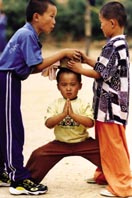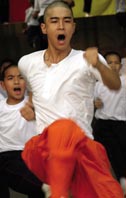Most Chinese people of middle-age clearly remember the first kungfu film: 1982's Shaolin Temple. The film portrayed the love that grew between a young Shaolin monk and a shepherd girl. It also brought significant changes to Henan Province's Shaolin Temple. Before 1982, only 200,000 tourists visited annually, a number that increased to 2.6 million by 1984.
Inspired by the movie, many Chinese youth decided to learn Shaolin style martial arts. Yan Lu of Shandong Province, was one. His parents gave him the name Lin Qinghua, hoping that he could go to Qinghua University, one of the best universities in China. Now a Shaolin monk, Yan Lu believes he's in the best Buddhist institute in China.
"I was deeply impressed by the movie Shaolin Temple and decided I wanted to be a heroic monk like Monk Jueyuan," Yan Lu says. "My father brought me here, because he wanted me to learn some Shaolin kungfu skills, but I was drawn to Buddhism and so decided to stay." Yan Lu is now head coach of the Shaolin Temple warrior monk team.
Even now, many teenagers come to Shaolin Temple with the dream of becoming a warrior monk, for which the most important requirement is a solid character. A novice has to be trained for as long as three years, and starts by doing chores to test the patience. "Now that young people have better living conditions, they are more impetuous and influenced by TV and movies, and so find it hard to concentrate on learning the basic skills," Yan Lu says. "They imagine they can learn good kungfu skills in just a few days. Some come purely to study martial arts skills and leave immediately after. Our temple now has some 100 monks." Foreigners also come to the Shaolin Temple to study. Requirement for them are simpler -valid identification and good physical condition.

Yan Da is another monk who came to the Shaolin Temple after watching the movie. His mother is a vegetarian and Buddhist which was a positive influence on Yan Da. "I did not need to go to school any more, and there was not the pressure from my parents to be successful in society," says Yan Da. "The other monks were like brothers to me, and the abbot treated me like his son. I was playing all day. It was great fun." Of course, there were times when Yan Da felt lonely and depressed, but he considered it part of the process of tempering himself. He was tested for three months during which he did some dirty chores, such as sweeping the floor, taking care of the boiler room and cleaning the toilet. Even then, he enjoyed temple life more than family life.
Yan Da is one of the temple's scholar monks, some of whom go on to be abbots. When he graduated from the Chinese Buddhist Institute in 2003, he came back to Shaolin with a new understanding of Buddhism and the meaning of life. He sees monks as human being better at controlling emotions and desires than others, because they realize that love, marriage and luxurious consumption are temporal and that only the happiness of the soul is lasting. Yan Da has many secular friends who frequently send him e-mails and text messages and asking for his help when they are in distress. "Many people say that monks live a hard life, but I think that secular people's lives are far more painful," he says. "they have to take care of their parents, love their spouses and children and take responsibility for all of them. We monks are only responsible to ourselves and the temple, our lives are very simple."
One of the few monks that have received higher education, Yan Da quickly rose through the temple ranks and is now in charge of external liaison affairs. The monks do not have fixed posts, but the abbot meets with them every six months. If he invites a monk for tea, it indicates satisfaction with their conduct.
"Living conditions in the temple are comfortable enough," Yan Da says. "Too many luxuries makes it difficult to keep to Buddhist doctrine." The monks' life is not actually as rigid as might be imagined. They have television and VCDs, some monks have mobiles, and they are given several hundred yuan each month for expenses. Yan Da spends most of his money on phone bills and books. His dream is to walk from Beijing to the Wutai Mountains, a sacred Buddhist area, six hours by train from Beijing, and estimated to take about one month on foot.
Since the 1990s, the annual number of tourists to Shaolin Temple has maintained a constant level of 1.5 million, foreign tourists number about 200,000. Tourism is becoming the economic backbone of Dengfeng County. Every year, the temple sells 100 million yuan in admission tickets, accounting for 60 percent of the county's tourism income.
Meanwhile, martial arts schools around the temple have flourished. The first government-run martial arts school -- the Dengfeng Martial Arts School, was founded by the Dengfeng county government in 1958. There are now 83 registered martial arts schools in the county, and more than 100 unregistered schools, most of whom use the Shaolin name to attract students.
The Shaolin Tagou Martial Arts School has 15,000 teachers and students, and is the largest martial arts school in the world. It used to neighbor the Shaolin Temple. "Our school brought many visitors and much business opportunity to the local people," says Liu Haiqin school principal. "Local residents rent their houses to our students, and the students frequent local restaurants and grocery stores. The local post office has a monthly sales volume of 1,000 yuan in our holiday season, but during the school months, that number is between 200,000 and 300,000 yuan.

Shi Xiaolong, a child martial arts star popular in Southeast Asia, was trained at his father's Dengeng martial arts school. He now runs the Little Dragon Martial Arts School with his father. Locals speculate that he earned 1.5 million yuan in the mid-1990s at the age of 8.
Shaolin is also becoming a famous commercial brand in China. At present, 54 Chinese commodities have registered the Shaolin trademark, ranging from beer, furniture, auto tires, and electric wires to hot pots and hotels. As from 1998, the Shaolin Temple had its own official trademark and established the Shaolin Temple Industrial Development Co. It has also set up a joint venture with a Hong Kong company to sell two of its own products, vegetarian cake and Shaolin Zen Tea.
Another company under the Shaolin Temple is the Henan Shaolin Film Co., Ltd. The temple also runs its own martial arts school -- the Songshan Shaolin Temple Warrior Monk Training Base. To promote Shaolin culture, its abbot Master Yongxin established the Shaolin Boxing Research Society, the Shaolin Painting and Calligraphy Academy, the Shaolin Temple Warrior Monk Team and a magazine called Zen. With his support, the temple also set up its own website to disseminate Buddhism and kungfu. He sends his monks abroad to coach foreign students, and has toured around the world lecturing on Buddhism and the kungfu spirit of his temple. Yongxin has led his warrior monks to more than 20 countries, including the United States, the United Kingdom and Japan. The Shaolin Temple now has overseas branches in London, Berlin, Budapest and Vienna.
Yongxin's most pressing concern is that Shaolin kungfu is being corrupted by standardized sports competition. In 1928, the China National Martial Arts School was established and brought martial arts to world sports competitions, albeit modified to suit Western competition rules. In 1959, martial arts became a formal competitive event in the First National Sports Games, and was accepted as a new event in the Asian Games in 1990. It was thus totally standardized. "In the standardization process, Shaolin kungfu has undergone dramatic changes," Yongxin says. "The original emphasis of Shaolin kungfu is on contained internal organ exercises, which have now been superseded by those similar to acrobatic and dancing performances. Such styles are popular in martial arts schools, and their ultimate aim is very simple -- to win gold medals. This is not the Shaolin spirit."
The abbot explained that Shaolin kungfu is different from martial arts. Kungfu is a Buddhist practice with the purpose of purifying the soul and building character. Both scripture chanting and skill exercises are Buddhist practices in the temple. There are now 445 Shaolin kungfu routines designed according to rules of movement and reactions to opponents. It also reflects the traditional Chinese philosophy of yin and yang and natural harmony.
In order to protect Shaolin kungfu that has existed for 1,500 years, the forty-one-year-old abbot hopes that it will be included on UNESCO's Oral and Intangible Heritage of Humanity list. The Shaolin Temple is now undergoing a 300 million yuan renovation project with the aim of preserving the true spirit of Shaolin.
(China Today September 10, 2004)

